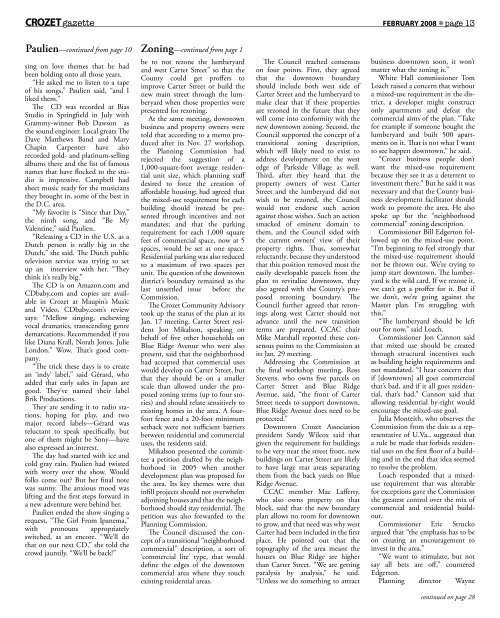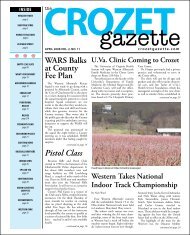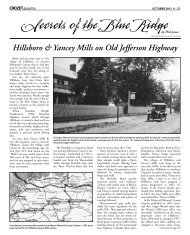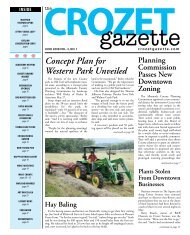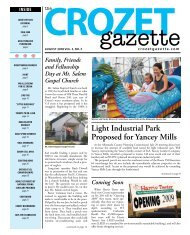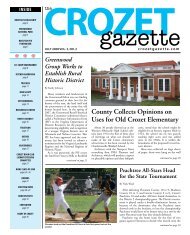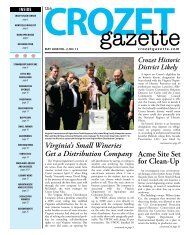Downtown Zoning Plan Drops Lumber Yard, West ... - Crozet Gazette
Downtown Zoning Plan Drops Lumber Yard, West ... - Crozet Gazette
Downtown Zoning Plan Drops Lumber Yard, West ... - Crozet Gazette
Create successful ePaper yourself
Turn your PDF publications into a flip-book with our unique Google optimized e-Paper software.
<strong>Crozet</strong> gazette february 2008 s page 13Paulien—continued from page 10sing on love themes that he hadbeen holding onto all those years.“He asked me to listen to a tapeof his songs,” Paulien said, “and Iliked them.”The CD was recorded at BiasStudio in Springfield in July withGrammy-winner Bob Dawson asthe sound engineer. Local greats TheDave Matthews Band and MaryChapin Carpenter have alsorecorded gold- and platinum-sellingalbums there and the list of famousnames that have flocked to the studiois impressive. Campbell hadsheet music ready for the musiciansthey brought in, some of the best inthe D.C. area.“My favorite is “Since that Day,”the ninth song, and “Be MyValentine,” said Paulien.“Releasing a CD in the U.S. as aDutch person is really big to theDutch,” she said. The Dutch publictelevision service was trying to setup an interview with her. “Theythink it’s really big.”The CD is on Amazon.com andCDbaby.com and copies are availablein <strong>Crozet</strong> at Maupin’s Musicand Video. CDbaby.com’s reviewsays: “Mellow singing, eschewingvocal dramatics, transcending genredemarcations. Recommended if youlike Diana Krall, Norah Jones, JulieLondon.” Wow. That’s good company.“The trick these days is to createan ‘indy’ label,” said Gérard, whoadded that early sales in Japan aregood. They’ve named their labelBrik Productions.They are sending it to radio stations,hoping for play, and twomajor record labels —Gérard wasreluctant to speak specifically, butone of them might be Sony—havealso expressed an interest.The day had started with ice andcold gray rain. Paulien had twistedwith worry over the show. Wouldfolks come out? But her final notewas sunny. The anxious mood waslifting and the first steps forward ina new adventure were behind her.Paulien ended the show singing arequest, “The Girl From Ipanema,”with pronouns appropriatelyswitched, as an encore. “We’ll dothat on our next CD,” she told thecrowd jauntily. “We’ll be back!”<strong>Zoning</strong>—continued from page 1be to not rezone the lumberyardand west Carter Street” so that theCounty could get proffers toimprove Carter Street or build thenew main street through the lumberyardwhen those properties werepresented for rezoning.At the same meeting, downtownbusiness and property owners weretold that according to a memo producedafter its Nov. 27 workshop,the <strong>Plan</strong>ning Commission hadrejected the suggestion of a1,000-square-foot average residentialunit size, which planning staffdesired to force the creation ofaffordable housing; had agreed thatthe mixed-use requirement for eachbuilding should instead be presentedthrough incentives and notmandates; and that the parkingrequirement for each 1,000 squarefeet of commercial space, now at 5spaces, would be set at one space.Residential parking was also reducedto a maximum of two spaces perunit. The question of the downtowndistrict’s boundary remained as thelast unsettled issue before theCommission.The <strong>Crozet</strong> Community Advisorytook up the status of the plan at itsJan. 17 meeting. Carter Street residentJon Mikalson, speaking onbehalf of five other households onBlue Ridge Avenue who were alsopresent, said that the neighborhoodhad accepted that commercial useswould develop on Carter Street, butthat they should be on a smallerscale than allowed under the proposedzoning terms (up to four stories)and should relate sensitively toexisting homes in the area. A fourfootfence and a 20-foot minimumsetback were not sufficient barriersbetween residential and commercialuses, the residents said.Mikalson presented the committeea petition drafted by the neighborhoodin 2005 when anotherdevelopment plan was proposed forthe area. Its key themes were thatinfill projects should not overwhelmadjoining houses and that the neighborhoodshould stay residential. Thepetition was also forwarded to the<strong>Plan</strong>ning Commission.The Council discussed the conceptof a transitional “neighborhoodcommercial” description, a sort of‘commercial lite’ type, that woulddefine the edges of the downtowncommercial area where they touchexisting residential areas.The Council reached consensuson four points. First, they agreedthat the downtown boundaryshould include both west side ofCarter Street and the lumberyard tomake clear that if these propertiesare rezoned in the future that theywill come into conformity with thenew downtown zoning. Second, theCouncil supported the concept of atransitional zoning description,which will likely need to exist toaddress development on the westedge of Parkside Village as well.Third, after they heard that theproperty owners of west CarterStreet and the lumberyard did notwish to be rezoned, the Councilwould not endorse such actionagainst those wishes. Such an actionsmacked of eminent domain tothem, and the Council sided withthe current owners’ view of theirproperty rights. Thus, somewhatreluctantly, because they understoodthat this position removed most theeasily developable parcels from theplan to revitalize downtown, theyalso agreed with the County’s proposedrezoning boundary. TheCouncil further agreed that rezoningsalong west Carter should notadvance until the new transitionterms are prepared. CCAC chairMike Marshall reported these consensuspoints to the Commission atits Jan. 29 meeting.Addressing the Commission atthe final workshop meeting, RossStevens, who owns five parcels onCarter Street and Blue RidgeAvenue, said, “the front of CarterStreet needs to support downtown.Blue Ridge Avenue does need to beprotected.”<strong>Downtown</strong> <strong>Crozet</strong> Associationpresident Sandy Wilcox said thatgiven the requirement for buildingsto be very near the street front, newbuildings on Carter Street are likelyto have large rear areas separatingthem from the back yards on BlueRidge Avenue.CCAC member Mac Lafferty,who also owns property on thatblock, said that the new boundaryplan allows no room for downtownto grow, and that need was why westCarter had been included in the firstplace. He pointed out that thetopography of the area meant thehouses on Blue Ridge are higherthan Carter Street. “We are gettingparalysis by analysis,” he said.“Unless we do something to attractbusiness downtown soon, it won’tmatter what the zoning is.”White Hall commissioner TomLoach raised a concern that withouta mixed-use requirement in the district,a developer might constructonly apartments and defeat thecommercial aims of the plan. “Takefor example if someone bought thelumberyard and built 500 apartmentson it. That is not what I wantto see happen downtown,” he said.“<strong>Crozet</strong> business people don’twant the mixed-use requirementbecause they see it as a deterrent toinvestment there.” But he said it wasnecessary and that the County businessdevelopment facilitator shouldwork to promote the area. He alsospoke up for the “neighborhoodcommercial” zoning description.Commissioner Bill Edgerton followedup on the mixed-use point.“I’m beginning to feel strongly thatthe mixed-use requirement shouldnot be thrown out. We’re trying tojump start downtown. The lumberyardis the wild card. If we rezone it,we can’t get a proffer for it. But ifwe don’t, we’re going against theMaster plan. I’m struggling withthis.”“The lumberyard should be leftout for now,” said Loach.Commissioner Jon Cannon saidthat mixed use should be createdthrough structural incentives suchas building height requirements andnot mandated. “I hear concern thatif [downtown] all goes commercialthat’s bad, and if it all goes residential,that’s bad.” Cannon said thatallowing residential by-right wouldencourage the mixed-use goal.Julia Monteith, who observes theCommission from the dais as a representativeof U.Va., suggested thata rule be made that forbids residentialuses on the first floor of a buildingand in the end that idea seemedto resolve the problem.Loach responded that a mixeduserequirement that was alterablefor exceptions gave the Commissionthe greatest control over the mix ofcommercial and residential buildout.Commissioner Eric Struckoargued that “the emphasis has to beon creating an encouragement toinvest in the area.”“We want to stimulate, but notsay all bets are off,” counteredEdgerton.<strong>Plan</strong>ning director Waynecontinued on page 28


